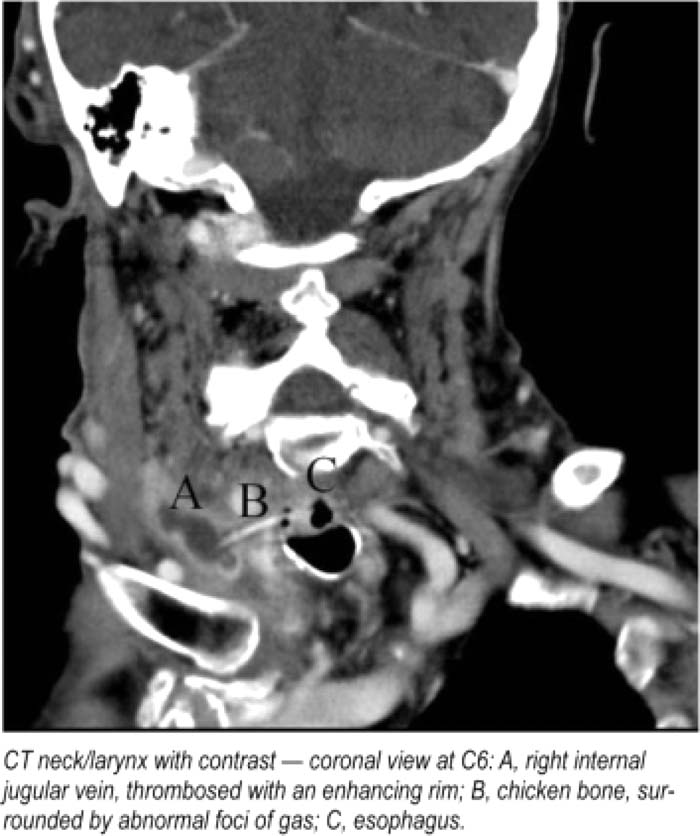Case Presentation:
A 90‐year‐old female with a history of Alzheimer's presented with a 1‐day history of fever and confusion. Initial blood pressure was 91/56, and temperature was 102.8°F. The patient was oriented but had difficulty answering other questions. Exam revealed right neck induration without fluctuance or crepitus. After blood cultures were drawn, broad‐spectrum IV antibiotics were initiated. Multiple blood cultures grew out Streptococcus mitis and S. sativarius, both within the viridans group. A contrast enhanced CT of the neck and larynx revealed a linear high‐density foreign body extending from the esophagus into the right internal jugular vein (IJV) with evidence of thrombophlebitis and extension of the abscess into the adjacent soft tissues. She was taken to surgery. Thoracic surgery performed an EGD and removed a chicken bone within the cervical esophagus. An area of mucosal trauma but no perforation was visualized. ENT then drained the deep neck abscess and vascular surgery resected the segment of the IJV which was completely thrombosed, fibrolic, and purulent. Postoperatively, the patient did well while on ceftriaxone and Flagyl and was started on TPN. Given her advanced age with poor baseline functional status, the family ultimately decided to pursue hospice care.
Discussion:
Esophageal perforation is usually iatrogenic or spontaneous (Boerhaave's syndrome). Swallowed foreign bodies such as chicken and fish bones are rare causes. These bones, after perforating the cervical esophagus, can then perforate the aorta, subclavian artery, or pericardium. To our knowledge, this is the first report of a chicken bone perforating the esophagus and causing septic thrombophlebitis of the internal jugular vein. Septic thrombosis of the IJV is typically caused by infection of central venous catheters or progression ol an oropharyngeal infection with Fusobacterium nectophotvm, Lemierres syndrome. Septic thrombophlebitis of the deep veins is a serious, life‐threatening condition and can also lead to significant morbidity because of metastatic abscesses. Successful treatment depends on prompt initiation of an extended course of broad‐spectrum IV antibiotics along with appropriate imaging studies to detect thrombosis of deep venous vessels, followed by adequate surgical drainage of any abscesses.
Conclusions:
Although rare, the possibility of foreign body perforation of the esophagus should be considered in a patient with polymicrobial Streptococcus viridans bacteremia.
Author Disclosure:
M. Doi, none.

